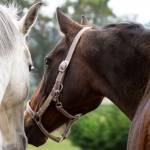Factors Affecting the Stallion’s Reproductive System

Stallions are sometimes expected to be fertile with normal sperm counts all year, every year. However, as with the mare, the fertility in the stallion varies according to the season.
The sperm count (concentration of sperm per ejaculate) is lower in late autumn and winter, being only about half of that in spring and summer. The stud manager should not overwork the stallion at this time. The total semen volume is lower in winter, and a stallion is much slower to mate (less interested) in late autumn and winter, and is also more likely not to ejaculate even when he does serve a mare.
The fertility of a stallion depends on several factors:
- Total sperm production.
- Percentage of motile normal sperm. A large daily sperm production will be ineffective if the sperm are not motile.
- Size of the testicles. Stallions with larger testicles are generally more fertile than stallions with smaller testicles because they produce a greater number of sperm per day.
- Frequency of ejaculation. If a stallion serves two mares one hour apart, the second mare receives only half the quantity of sperm that the first mare receives. If the stallion has average fertility, the second mare receives enough sperm to enable her to conceive, but if the stallion has poor fertility she may not conceive.
- Illness or stress. Sperm produced in the testes take almost 60 days to mature and be ready for ejaculation. If a stallion becomes stressed or ill, causing sperm production to cease or resulting in deformed, infertile sperm, the effect on fertility will not be seen until 60 days later.
- Handling and care. Mistreatment during breeding will affect the stallion’s behavior and thus desire to mate. Excessive roughness, excessive use as a teaser, isolation from other horses, boredom, and stress are all factors that can cause abnormal behavior and affect the stallion’s desire to mate and ejaculate.
A veterinary examination to assess the stallion’s fertility should be carried out prior to purchase. Mature stallions with normal fertility can serve two or three mares each day of the week without lowering their fertility. Younger stallions, aged two or three years, should be used less frequently. Two or three services a week in their first season may be enough because their ability to produce sperm is lower than the mature stallion. The number of mares booked to a young stallion is not the criterion. The number of services given per week is the critical factor with regard to fertility, and a veterinary examination of mares to determine their suitability for service is more important.
In terms of supplements, there is a wide variety of products designed to support and possibly enhance stallion fertility, including vitamins (specifically A and E), omega-3 fatty acids (including EPA and DHA), antioxidants, and more. EO-3, a nutritional supplement developed by Kentucky Equine Research (KER), is a rich source of EPA and DHA, and supports sperm concentration, motility, and viability.
As with any supplement, choose your product wisely to avoid poor-quality supplements that are unlikely to be effective.








